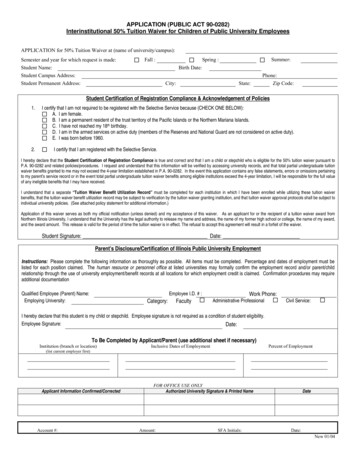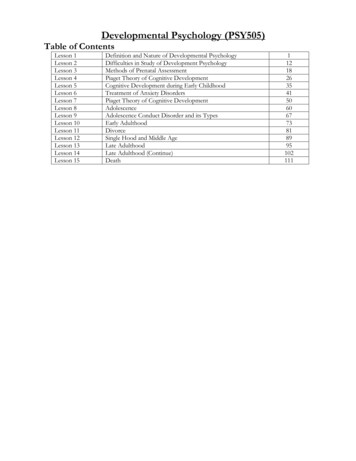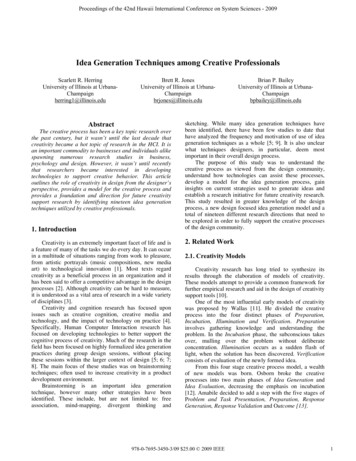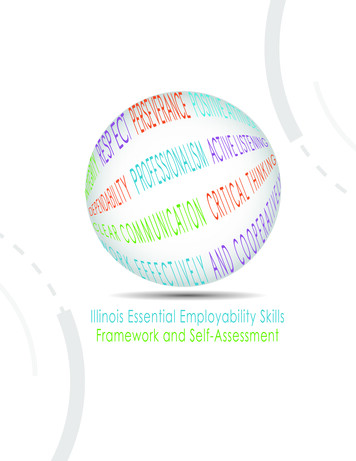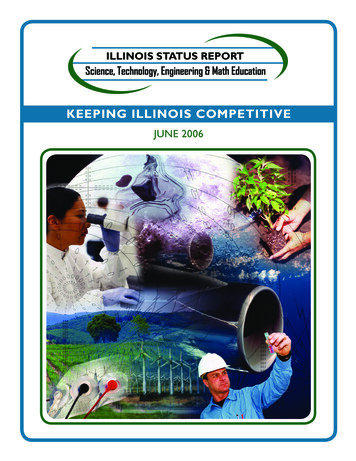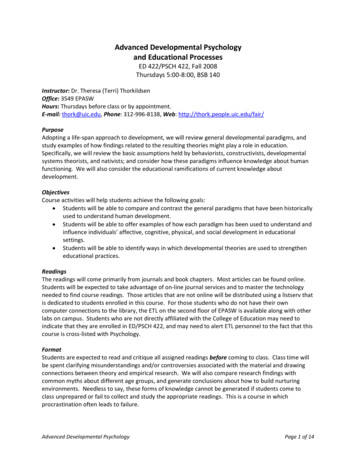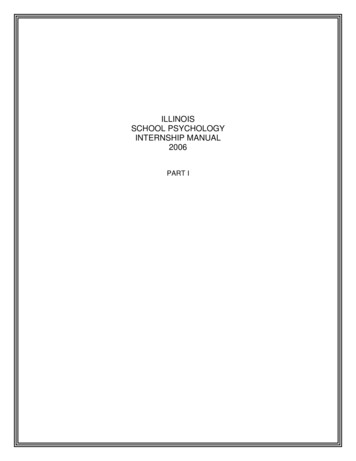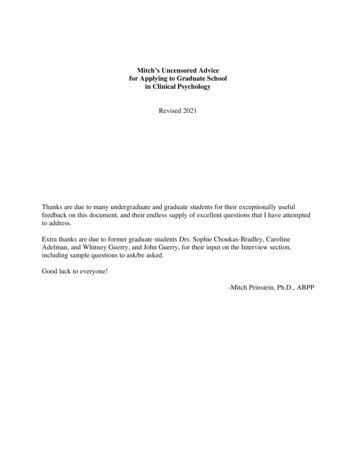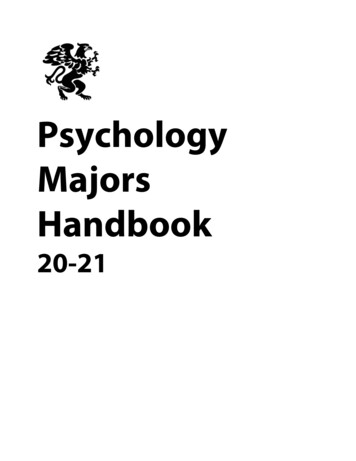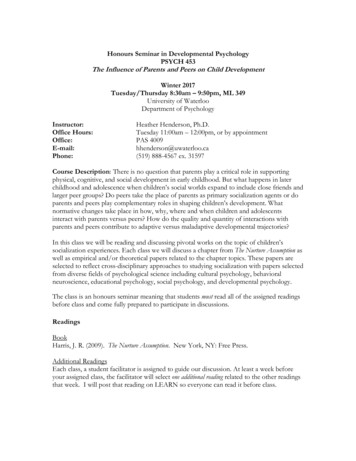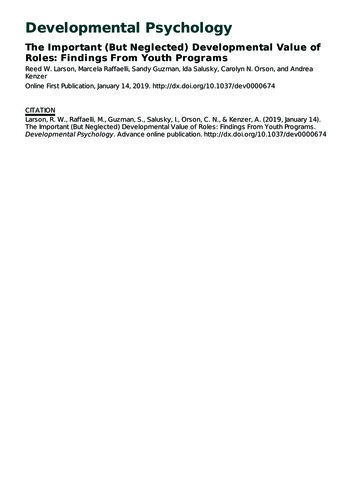
Transcription
Developmental PsychologyThe Important (But Neglected) Developmental Value ofRoles: Findings From Youth ProgramsReed W. Larson, Marcela Raffaelli, Sandy Guzman, Ida Salusky, Carolyn N. Orson, and AndreaKenzerOnline First Publication, January 14, 2019. , R. W., Raffaelli, M., Guzman, S., Salusky, I., Orson, C. N., & Kenzer, A. (2019, January 14).The Important (But Neglected) Developmental Value of Roles: Findings From Youth Programs.Developmental Psychology. Advance online publication. http://dx.doi.org/10.1037/dev0000674
Developmental Psychology 2019 American Psychological Association0012-1649/19/ 12.002019, Vol. 1, No. 999, 000http://dx.doi.org/10.1037/dev0000674The Important (But Neglected) Developmental Value of Roles:Findings From Youth ProgramsReed W. Larson, Marcela Raffaelli,and Sandy GuzmanIda SaluskyDePaul UniversityThis document is copyrighted by the American Psychological Association or one of its allied publishers.This article is intended solely for the personal use of the individual user and is not to be disseminated broadly.University of Illinois at Urbana-ChampaignCarolyn N. Orson and Andrea KenzerUniversity of Illinois at Urbana-ChampaignDevelopmental theory historically viewed demanding roles (at home, job) as important developmentalcontexts. However, adolescents’ participation in these roles has fallen. This qualitative research examinedrole experiences in United States youth development programs. A central question among others was,“How can youth experience internal motivation fulfilling externally imposed role obligations?” Weinterviewed 73 youth with substantive work roles (e.g., Leader, Reporter, and Teacher) in 13 arts,science-technology, and leadership programs. Youth (51% female) were 14- to 18-years-old andethnically diverse. We used grounded-theory methods suited to understanding youth’s active learningprocesses in context. Findings illuminated youth’s experiences in 4 important transactions or “steps.”Youth: (a) accepted roles based on personal goals, (b) encountered difficult challenges similar to adultroles (e.g., conflicting viewpoints, role strain), (c) drew on resources to overcome challenges and fulfillrole demands, and (d) learned through these experiences. Across these steps, findings suggested 3powerful development processes. First, youth experienced multiple sources of internal motivation (e.g.,agency within roles, personal and social investment, and “good pressure”), which fostered high engagement in role performance and learning. Second, experiences grappling with and fulfilling difficult roledemands helped youth build important competencies for action (e.g., strategic thinking, perseverance).Third, youth’s experience of accountability to others served as a powerful driver of responsibilitydevelopment: Because youth were invested, they took ownership of obligations to others and learnedresponsive modes of thinking and acting, which they transferred to family, school, and elsewhere. Wepropose that teens would benefit from more opportunities for role experiences like these.Keywords: youth development programs, social roles, youth practice, social-emotional development,moral developmentIn classical developmental theory, roles were viewed as important vehicles of development and socialization. Young people’sexperiences holding meaningful substantive roles— on the farm,caring for children, on a job—were seen to provide valuableopportunities for social-emotional learning, identity development,and socialization into society (Barker & Wright, 1955; Coleman etal., 1974; Mead, 1934). This theory influenced Bronfenbrenner(1979) to include roles as one of three “building blocks” of themicrosystem (with relationships and activities). Bronfenbrennerargued that “roles have a magiclike power to alter how a person istreated, how she acts” (p. 6), and that young people developthrough active “participation in an ever-broadening role repertoire” (p. 104). Studies find that having roles in school is related toincreased prosocial behavior (Rutter, Maughan, Mortimore, &Ouston, 1979) and longitudinal research suggests that having a jobas a teen contributes to positive functioning in adult roles (Mortimer, 2003; Staff & Mortimer, 2008).Despite theory and research supporting the value of roles, manypostindustrial societies have been moving in the opposite direction.Adolescents spend less time on household responsibilities and paidjobs than teens in traditional societies (Larson & Verma, 1999;Schlegel & Barry, 1991). In the United States, across the pastcentury teens have had progressively fewer household roles (Goldscheider & Waite, 1993; Hofferth, 2009) and in recent decadesReed W. Larson, Marcela Raffaelli, and Sandy Guzman, Department ofHuman Development and Family Studies, University of Illinois at UrbanaChampaign; Ida Salusky, Department of Psychology, DePaul University;Carolyn N. Orson and Andrea Kenzer, Department of Human Development and Family Studies, University of Illinois at Urbana-Champaign.Findings were presented at the biennial meetings of the Society forResearch on Adolescence in March 2016. This research was supported bya grant from the William T. Grant Foundation (Reed W. Larson, P.I.;Marcela Raffaelli, co-P.I.). We thank the participants in this study andacknowledge valuable contributions by Brent Roberts, Vanida Vesunitia,Kristen Herdegen, Gina McGovern, and other members of the PathwaysProject research team.Correspondence concerning this article should be addressed to Reed W.Larson, Department of Human Development and Family Studies, University of Illinois at Urbana-Champaign, 904 West Nevada Street, MC 081,Urbana, IL 61801. E-mail: larsonr@illinois.edu1
LARSON ET AL.This document is copyrighted by the American Psychological Association or one of its allied publishers.This article is intended solely for the personal use of the individual user and is not to be disseminated broadly.2fewer paid jobs (Morisi, 2017). Hence, they have less opportunityto gain the developmental benefits that roles might provide. Onereason for these trends may be that young people’s work is lessneeded than in the past (Morrison, 2017). They may also bebecause of growing ambivalence in Western culture about placingobligations on adolescents and new beliefs that emphasize allowing teens choice and supporting their development of autonomyand self-motivation (Ochs & Izquierdo, 2009; Twenge & Park,2017). However, are there conditions in which teens are motivatedto take roles? If so, what keeps them motivated and how do theseroles facilitate growth and learning?Youth development programs in the United States are settings inwhich teens hold substantive roles (Salusky et al., 2014), so theyare a promising context to examine role processes. Youth programs include extracurricular school activities and communitybased programs in which adolescents meet on a regular schedule toparticipate in activities, such as arts, technology, and leadershipactivities, under the supervision of adult staff. Youth developmentprograms are widespread in the United States: 83% of 12- to17-year-olds report participating in at least one program or extracurricular activity in the past year (Moore, Hatcher, Vandivere, &Brown, 2000). United States programs have a shared institutionalphilosophy that emphasizes youth decision-making, supportiverelationships, and empowering participants as agents of development (Eccles & Gootman, 2002; Lerner et al., 2013). Memberstake roles such as activity leaders, cameraperson, or committeechair, which may provide special opportunities for these agenticlearning processes.The goal of this research was to examine adolescents’ experiences holding substantive roles in youth programs. We wanted tounderstand program roles as opportunity structures or “developmental systems” (Lerner & Tolan, 2016) that facilitate processes ofpositive development. We ask what motivates youth to acceptroles, how they respond when they encounter difficult demands,and how role experiences facilitate developmental change. Ultimately, we are concerned with the applied goal of understandinghow to make roles function successfully to facilitate development.Given limited prior research, we sought to build grounded theoryabout these processes using methods of qualitative research (National Institutes of Mental Health Consortium of Editors on Development & Psychopathology, 1999). We analyzed interview datacollected from 14 –18-year-old youth holding roles in diverseprograms.Literature ReviewRole TheoryAlthough many definitions have been provided for “roles,” thereis general consensus on the basics. Roles are structures. A role isa set of socially constructed or coconstructed norms and expectations placed upon the role occupant. Roles typically occur withininstitutional contexts (e.g., a family or organization) and are organized around functions (Biddle, 1986; Newman & Newman,2016). By “substantive roles” we refer to roles where the expectations include obligations to perform work and fulfill specificfunctions.The obligations of roles are theorized to be central active ingredients that drive developmental change. Development occursthrough a person encountering new role demands, learning toaddress them, and successfully fulfilling expectations (Biddle &Thomas, 1966; Roberts & Davis, 2016). The experience of successin the role provides positive reflected images (from self and others)of oneself effectively responding to social needs, which leads tointernalization of role behavior (Burke, 1991; Mead, 1934).Role theory may be helpful in suggesting what could motivateteens to accept role obligations. Sieber (1974) posited that inaddition to duties: “Every role carries with it certain rights . . . andthese serve as inducements for recruitment to roles and . . . thecontinuation of role performance.” The role holder is given amandate (within limits) to exercise agency in how they fulfill therole obligations and functions (Berger & Luckmann, 1966); andexperiencing agency is an established contributor to internal motivation (Deci & Ryan, 2012).However, can these opportunities for agency be structured inways that sustain teens’ motivation? Research with adults showsthat role obligations can be difficult and stressful. Adult work rolesimpose social controls, subject role holders to conflicting pressures, and may create role overload (Biddle, 1979; Gross, McEachern, & Mason, 1966). These can undermine role occupants’ experience of agency and internal motivation (Ashforth, 2001). Doteens’ roles in programs present similar stressful demands and dothey undermine motivation?Recent research with adults suggests another type of internalmotivation that may support perseverance through difficult roledemands: social investment. Roberts and colleagues theorize thatbeing socially and psychologically invested in a role is an important motivator of both role perseverance and developmentalchange (Roberts & Wood, 2006). They found that young adultswith greater investment in their jobs showed longitudinal increasesin conscientiousness and emotional stability (Hudson, Roberts, &Lodi-Smith, 2012; Roberts & Davis, 2016). Might teens’ programroles engender a level of investment that supports similar developmental change?Youth Programs as Contexts for Role ExperiencesYouth programs provide favorable conditions for role experiences. They support motivation: Adolescents’ participation in programs is voluntary and high-quality programs have a motivatingsocial environment (e.g., caring relationships) and activity environment (e.g., support for youth agency; Larson, McGovern, &Orson, in press). Further, professional program leaders are trainedto facilitate youth-driven learning experiences (Smith, McGovern,Larson, Hillaker, & Peck, 2016). In programs for high-school-agedteens, roles are often situated within long-term group projects (e.g.,creating a film, planning an event; Larson & Angus, 2011).We observed the possible significance of program roles in apilot study focused on the development of responsibility. We asked20 teens in four programs to describe their experiences withprogram “responsibilities and roles.” Their accounts suggestedthat: youth took roles seriously, roles could be demanding, andyouth learned from them (Salusky et al., 2014). We also discovered critical unasked questions, for example, about youth’s roleinvestment, peer dynamics, and developmental processes. Although the pilot’s small size limited power for detecting robustpatterns, a useful finding was discovery of four “steps” in youth’srole experiences that appeared to represent consequential transac-
This document is copyrighted by the American Psychological Association or one of its allied publishers.This article is intended solely for the personal use of the individual user and is not to be disseminated broadly.DEVELOPMENTAL VALUE OF ROLEStions between the youth and role. The pilot (and role theory) alsosuggested preliminary focal research questions for each step,briefly summarized here.Step 1: Taking on a role. One set of focal questions dealswith how voluntarily youth obtain roles. Staff’s assignment ofyouth to roles may compromise their motivation (Parker & Hellison, 2001). Whether and why people want a role can be important(Ashforth, 2001). Youth in the pilot reported wanting their rolesbut the specific choice processes were unclear.Step 2: Experiencing role demands. Another set of questions is whether program roles confront youth with the kinds ofdifficulties found in adult roles (e.g., conflicting pressures, unexpected obligations) and how this effects them? Some pilot youthreported role strain, but information on specific role demands wasincomplete. Given U.S. youth’s limited experience with substantive roles, we wanted to understand their experiences dealing withrole obligations.Step 3: Fulfilling role demands. Experiencing high role demands and strain is not necessarily a bad thing if people aremotivated and able to overcome them (Roberts, Wood, & Smith,2005). In the pilot, most youth reported fulfilling their responsibilities or roles. Focal questions include: If roles become challenging and stressful, how are youth able to stick with them and fulfillthe obligations? What resources do they draw on? How mightpersonal investment, program leaders, or peers help youth overcome challenges?Step 4: Processes of developmental change. Youth in thepilot study reported that role experiences led to developmentalchange, including changes that transferred to contexts beyond theprogram. Fuller data are needed on what youth learn and howlearning and transfer occurs. Little research has examined howroles lead to developmental change for adults, let alone teens.This StudyWe used these four steps and focal questions as a starting placefor examining youth’s role experiences. Our goal was learninghow roles function as opportunity structures to support developmental processes—also any difficulties that might interfere withthese processes. An overarching question across steps was howexternally imposed role obligations support or interfere withyouth’s internal experiences of the role (e.g., their motivation,experiences of agency). Bronfenbrenner (1989) suggests that development is most likely when there is a “synergistic” relationshipbetween the environment and person. We asked whether programroles created this synergy between role demands and youth’sinternal experience.We conducted the study recognizing that role experiences arecomplex and varied. Performing a role can involve multilayeredtransactions with supervisors, colleagues, and people one is serving (Biddle, 1986). Experiences may vary by the role, programcontext, and other factors. We viewed sensitivity to this complexity as vital to examining role experiences. Because youth arecentral actors in role processes, we also felt it important to studythese experiences from their viewpoint—as they took on, enacted,and learned from roles. Qualitative methods are well-suited tostudying these active developmental experiences in complex, varied contexts (Lerner & Tolan, 2016). (Qualitative methods are notsuited to controlled study of individual differences, so that was not3a goal). While recognizing this complexity, our main aim waslooking for similarities across experiences in how roles facilitateyouth’s development.MethodInterviews for this study were conducted with 73 high-schoolage teens who had substantive roles within 13 community andschool-based youth development programs.Program Selection and ProceduresThese data were collected as part of a multicomponent study ofdevelopmental processes in youth programs. We selected programs that met criteria associated with program quality (e.g.,experienced staff, low youth turnover, at least 100 contact hours)and other characteristics (e.g., served primarily low- and middleincome families, mixed gender). Programs were recruited fromthree research locations in the Midwestern United States: Chicago,Central Illinois, and Minneapolis (4 –5 programs each). Reflectingthe larger study’s goals, we recruited seven programs that servedprimarily Latinx adolescents (2–3 from each location). All programs were project-based; we obtained a mix of arts, leadership,and science-technology from each location (Griffith & Larson,2016).Following Institutional Review Board (IRB) approved procedures (Institution University of Illinois, project title PathwaysProject/Proyecto Caminos: Youth Programs and Families, IRBprotocol number 11663), a research team member presentedinformation about the study to youth in the program and gave thema parent information letter (in English and Spanish) that describedthe study and gave instructions for opting youth out of the study;youth assent was also obtained. Participants received modest monetary incentives for each interview.The interviewed youth were a subset of program youth in theprograms and in the larger study. The full sample (n 355; 94.4%of youth in the 13 programs) completed quantitative questionnairesat four time points across the program cycle (typically a schoolyear). A subset of these youth (n 54; the “prospective sample”)took part in four individual interviews (Times 1– 4) and anothersubset (n 54; the “retrospective sample”) took part in a singleinterview at the end of the program cycle (Time 4). Intervieweeswere selected based on their questionnaire data using purposivequota selection (Miles, Huberman, & Saldana, 2014) with the goalof obtaining a sample with 8 –12 youth per program that wasbalanced in terms of gender; mirrored each programs’ membership(e.g., ethnicity, years of program experience); and (consistent withlarger study goals) reflected different levels of parental support(prospective sample) and responsibility development (retrospective sample). Comparisons of the 108 youth in the interviewsample with other study participants indicated no significant differences in gender, age, ethnicity, and years in program. Theinterview questions about roles were asked of the prospectivesample at Time 2 and the retrospective sample at Time 4.ParticipantsThe 73 teens (37 girls, 36 boys) in the analytic sample for thisarticle consisted of youth in the interview samples who reported
4LARSON ET AL.holding substantive roles and were within the age range of 14 –18years (M 15.79, SD 1.20). These 73 youth were ethnicallydiverse (39.7% Latino/a, 35.6% African American or Black,21.9% European American, and 2.7% other ethnicities). On average, they had been in the program for about a year and a half (M 1.54, SD 1.51). The 73 did not differ significantly from otherinterviewed youth (N 35) in age, gender, ethnicity/race, or yearsin the program.This document is copyrighted by the American Psychological Association or one of its allied publishers.This article is intended solely for the personal use of the individual user and is not to be disseminated broadly.Interview Questions About Role ExperiencesThe interview protocol included 40 structured questions andprobes that asked about youth’s experiences with a program role.Items addressed the focal research questions and were designed toobtain detailed accounts of youth’s experiences across the foursteps. The questions began by eliciting a description of a majorrole the youth held (“What’s the biggest or most demanding roleyou’ve had in the program this year?”) and its associated expectations (“What are the responsibilities or demands that come withthat role?”). Youth with a role were then asked about their experiences, beginning with questions for Step 1 (e.g., “How did youget this role? Did you choose it, or did someone else give it toyou?”), and motivations (“Why did you want this role?”). Questions for Step 2 asked about experiences with role obligations (e.g.,“Did the work or demands related to your role turn out to be morethan you expected? Explain.”). Questions for Step 3 included“What made you stick with your responsibilities” and how wereleaders and peers helpful? Questions for Step 4 asked about whatyouth learned from their role, whether learning transferred to homeor other contexts, and how learning and transfer occurred.AnalysesThe analyses examined youth’s unfolding role experiencesacross the four steps. Analyses were question-driven. They progressed from simple to more complex focal research questions toemergent questions about developmental processes. We used procedures of grounded theory and qualitative analysis designed forsystematic identification of repeated themes, structure, and processin narrative data (Charmaz, 2014; Strauss & Corbin, 1998).We first identified youth who held substantive roles. Our operational definition of “substantive” included roles with individualresponsibilities over time that entailed significant initiative, effort,and accountability (e.g., running meetings, writing an article, developing a theatrical character). We excluded youth whose responsibilities involved little decision-making (e.g., painting a wall) orlasted only 1 or 2 days (e.g., stepping in for President). Seventythree youth had roles that met these criteria.Procedures for main analyses. The analyses within each stepoften began with what we called “starter” focal research questions.These were aimed at obtaining confirmation (or disconfirmation)of an expectation suggested by the pilot study or role theory (e.g.,Did teens choose their roles? Were demands more than expected?).In nearly all cases, analysis of starter questions, focused on youth’sresponses to a specific interview item; and responses could readilybe coded as yes or no. Findings for youth’s aggregated responsesto these items (i.e., the percent of youth coded as “yes”), then ledinto analyses of related open-ended focal research questions. Thus,when we found that a majority of youth reported experiencingdemands that were greater than expected, we used qualitativemethods to analyze what the unexpected demands were.Qualitative analyses for open-ended research questions involvediterative cycles of: (a) identifying all relevant interview passages(typically from a specific item), (b) line-by-line open coding ofthese passages, (c) identifying conceptual “core ideas” for codingcategories and developing operational definitions for each, (d)independent coding of all passages using these categories by atleast two team members, (e) resolution of differences in assignedcodes based on methods of consensual coding (Charmaz, 2014;Hill et al., 2005), and (f) evaluation of all passages receiving eachcode for internal consistency and theoretical integrity. This evaluation stage often led us to revise operational definitions and insome cases to revise (or pose emergent) research questions, whichthen led to a new cycle of coding. For example, we discovered thatour initial focal question “Did youth choose roles voluntarily?”was too simplistic. So, we started anew focusing on two newquestions (youth’s choice in selecting role, wanting the role).This coding was conducted by a team that included a seniorresearcher (the PI), graduate students, and an undergraduate assistant. For each focal question, a pair of graduate student codersconducted stages a-e above, meeting periodically with the PI. Theentire team then met and conducted the evaluation stage. At thisstage, the PI served as auditor (critically reviewing all data for eachcode; Hill et al., 2005). Following best practices, decision-makingoccurred through discussions in which all members’ ideas werevoiced and considered. To ensure fidelity in coding, we followedadditional best practices, including continually going back to thefull interview transcripts to understand youth’s statements in adeeper context, looking across cases to ensure similarity in how aparticular type of response was coded, following procedures toinsure that minority views in the coding team were understood,incorporating decisions into the operational definitions, and regular memoing about issues and findings in the coding process.Our coding decisions were driven by two concurrent objectives.First, we created in vivo coding categories that were grounded inthe words and experiences of youth (Charmaz, 2014). Second, weformed categories and made decisions coding passages based onstandard qualitative criteria: constant comparison of similaritiesand differences, parsimony, fit to the focal question, and meaningfulness in relation to focal questions (Charmaz, 2014; Hill et al.,2005).We also strived for theoretical coherence among the codingcategories. One way we did this was to conduct theoretical analyses within and across each of the four steps to look for inconsistencies and opportunities to increase coherence (Strauss & Corbin,1998; Taylor & Bogdan, 1998). For example, within Step 2, wefound that difficult role demands could fruitfully be divided intoinstrumental and motivation challenges. This prompted us to examine whether assistance from program leaders and peers (in Step3) could be divided into instrumental and motivational support; wediscovered that it was both possible and increased coherence.Another way we sought theoretical coherence was to use “sensitizing concepts” from existent theory (e.g., role theory, motivational theory) to inform coding. Following Charmaz (2014) weused these to “guide but not . . . commandeer” formation of severalcoding categories (p. 30). For example, a number of focal questions across stages involved youth’s motivation. We found that thenewly introduced construct “internal motivation” was a valuable
This document is copyrighted by the American Psychological Association or one of its allied publishers.This article is intended solely for the personal use of the individual user and is not to be disseminated broadly.DEVELOPMENTAL VALUE OF ROLESumbrella concept to unify youth’s varied forms of eudemonicself-determined motivation (including intrinsic motivation, socialinvestment, personally meaningful goals, and internalized collective goals; Wrzesniewski et al., 2014). We chose internal ratherthan intrinsic motivation because it covers a broader set of motives, like purpose and investment (Schwartz & Wrzesniewski, inpress).Checking for demographic differences. Although examination of individual differences was not a study goal, before writingup findings, we checked if there were major differences in roleexperiences by a youth’s age, gender, ethnicity, and years inprogram. To evaluate this, we created categorical variables for 11higher order coding categories across the four steps. These wereperson-level variables based on analysis of the starter researchquestions (all but one had yes–no coding) for each main sectionand many subsections of the Findings. Among the 44 2 testscomputed, only one yielded a significant difference at the .05 level(more girls report demands bigger than expected, p .050).Because this rate of significance was not above chance, we onlyreport findings for the sample as a whole.Theoretical integration. Because our objective was to develop grounded theory, the final stage of theoretical analyses wasaimed at integrating findings across the steps. These integrativeanalyses identified three key development processes, which wereport in the Discussion section. It is important to keep in mind thatthe qualitative analytic methods we used are those of theorygeneration, not theory testing.FindingsA summary of core findings for each step is presented in Table1. The text of this section presents the conceptual story thatconnects the findings (Sandelowski, 1998). This includes the focaland emerging questions that drove analyses for each step, briefdescriptions of resulting coding categories, and quotes illustratingthe varied ways youth experienced each category in context. Although we report findings on four distinct steps, these did not5always occur in a fixed sequence. Encountering and fulfilling roledemands (Steps 2 and 3) often overlapped. Youth’s accounts oflearning processes (Step 4) often entailed processes in prior steps.Step 1. Taking on a RoleDescription of youth’s roles. A majority of the 73 youth withroles described having a “formal” role—like Dance Captain, Station Leader, Blogger, Mentor, and Secretary—that had a title andpredefined responsibilities. For example, Farid at Emerson HighSchool Drama Club served as Stage Crew Manager for a musical,and he described his responsibilities as: “You have to make sureeverybody’s ready, everything’s on time, know what things needto be out on stage at what points, and keep people quiet backstage.” A smaller number of youth described roles that wereinformal, shaped ad hoc to meet the requirements of a groupactivity or project; for example, being in charge of painting “thenatural girl” in a mural, or serving as the “go to senior” counselingnew members in the drama club. One program, Rising Leaders, didnot have formal roles. Instead, f
Developmental Psychology The Important (But Neglected) Developmental Value of . Reed W. Larson, Marcela Raffaelli, and Sandy Guzman, Department of Human Development and Family Studies, University of Illinois at Urbana-Champaign; Ida Salusky, Department of Psychology, DePaul University; Carolyn N. Orson and Andrea Kenzer, Department of Human .
